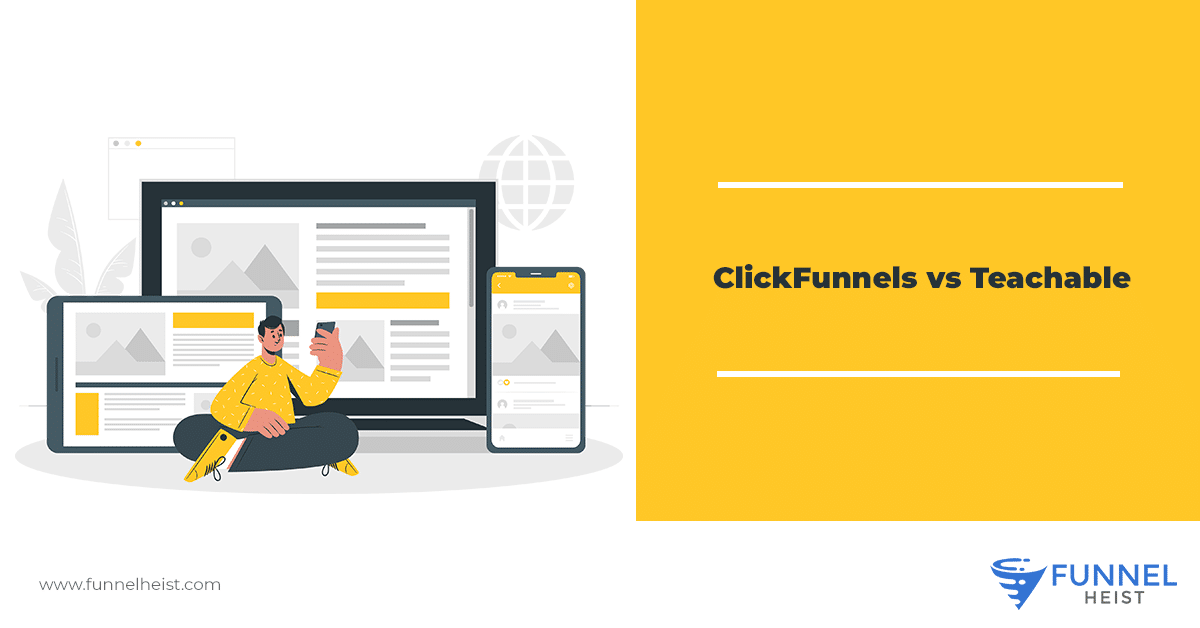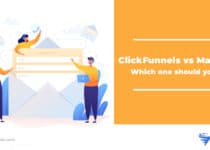ClickFunnels vs Teachable

When it comes to tools that allow you to develop and market your products online, there are several options out there that are available to you. Two of these platforms are ClickFunnels and Teachable.
Both of these tools are big names in their individual industries. ClickFunnels is the industry leader when it comes to creating sales funnels. In contrast, Teachable is one of the top learning management systems out there.
Get our FREE course on funnel building and marketing. We'll deliver it straight to your inbox! Learn about how to build and market your funnels for your business. The course includes a full tutorial on how to use ClickFunnels.![]()
Though they have similarities, there is an overlap in the way they can be used. If you are an online course creator, you can use both ClickFunnels and Teachable to market and sell your courses.
Both tools offer features to build websites and landing pages using a drag-and-drop editor interface. So, there can be a situation where you may need to choose between ClickFunnels and Teachable. We’re here to help you find out which of them is the better option for you and your business.
ClickFunnels
ClickFunnels started as a tool to help people create high-converting sales funnels online. It was one of the first tools to focus on sales funnels instead of being a more generic website builder.
Russell Brunson and Todd Dickerson founded ClickFunnels. It was created in 2014 when they realized that it took too much work and guesswork to put together sales pages online. That’s why they built a tool that can make the process quicker and more efficient.
Features of ClickFunnels
ClickFunnels focuses on 3 goals with its sales pages – generating leads, generating sales, and getting sign-ups for events.
When you start building a sales funnel with ClickFunnels, you will be choosing one of the 3 goals. Once you select a goal, it will automatically create the necessary framework to achieve it.
For instance, if you want to generate leads for your service business, you would be choosing lead generation as your goal on ClickFunnels. For this specific goal, it will help you create two different kinds of pages. The first is a page dedicated to capturing email addresses to build an email list. The other one is a more detailed form-based page containing information like visitor’s phone number, location, and anything else you need.
- Drag-and-Drop Editor
The drag-and-drop editor of ClickFunnels isn’t your average visual website builder. It focuses on building sales pages, and several features cater to that goal.
Its editor starts you off with templates designed for specific purposes. That includes pre-designed pages for opt-in pages, sales pages, upsell pages, order forms, webinar pages, and even ones to create membership areas on your website.
The ClickFunnels Editor shows its users exactly how these elements interact with each other and what kind of content should go into them. This feature makes it extremely simple to edit a template without violating the laws of building good sales funnels.
- Follow-Up Funnels
No matter how much you try, a sales page will not convert all the visitors who visited your web page. Some of them may be interested in your product but choose not to buy anything at that time.
The key is to not give up on these potential customers as they leave your sales page. In this case, you can use follow-up funnels to continue to pursue your audience with targeted messages.
The Smart Lists feature is the genius behind the follow-up funnels in ClickFunnels. It allows you to group email subscribers automatically based on specific actions that they’ve taken. So you can have email lists based on where visitors entered the funnel, buying history, and other actions that they’ve taken on your sales page.
Once you have set up the list, it will be easy to send them with targeted messages. You can send out emails, text messages, and broadcast notifications.
- Backpack
ClickFunnels’ affiliate management feature is known as the Backpack. With this feature, users can build their commission-only affiliate program.
ClickFunnels uses a tool called Sticky Cookies to incentivize affiliates further. Here’s how it works. For instance, someone arrives on your website using a particular Affiliate ID.
Now the affiliate partner who has that ID will be paid their share for that referral. They will also get a cut on other purchases that the customer makes on the website. Since affiliates have a greater earning potential because of Sticky Cookies, they are more likely to promote your product.
The Backpack also allows you to build two-tiered affiliate programs. So other affiliates can bring on board other affiliates and get a small cut on their commissions. With this feature, you can create your affiliate program without individually hiring each affiliate partner.
(READ More: Everything you need to know about ClickFunnels)
ClickFunnels Pricing
There are two ClickFunnels Pricing packages available.
- Basic Account (Starter Account)
The ClickFunnels pricing for this program is $97 per month. You will have the ability to create twenty funnels, over one hundred pages (whoa!), and up to 20,000 visitors per month.
- Etison Suite (Enterprise Account)
The ClickFunnels pricing for this program is $297 per month. You will receive Actionetics and a Backpack affiliate system. If you think you might want to use ClickFunnels as your “all in one” tool, including List Building, this may be for you. Besides, you can utilize ClickFunnels’ pricing as an affiliate.
(READ More: ClickFunnels Pricing Plans and Packages)
Teachable
Teachable is a learning management system. It can be used to build online courses and teach students remotely. Its products have become popular as more educators start to harness the internet’s power to grow their business or service.
Teachable primarily focuses on creating and selling courses. It provides people who want to teach online with all the tools needed. As long as you have something to teach or share to people, you can use this software to build a course around it and find an audience that wants to learn from you.
Features of Teachable
Teachable is used to build online courses. Users can create courses in different formats like text, video, and audio or combine them. You can also import existing content from Dropbox, OneDrive, and Google Drive to speed up the process.
- Website Builder
Once your course is complete, you’ll want to create a website so that visitors will know what you’re selling. You can do this by using Teachable.
The software has a drag-and-drop builder that you can use to create a website that talks about your online school. All the websites built using Teachable are fully responsive to reach students across different types of devices.
- Learning Tools
Teachable offers an assortment of tools to make sure that your students / learners stay engaged. It makes it easy to put together quizzes to gauge the learning level of students and reinforce concepts from particular lessons.
Another critical aspect of running a course is enforcing compliance. You want the students to complete individual lectures or get a specific quiz score before moving one. These requirements can be built into your courses.
- Marketing Tools
Teachable features a library of conversion-tested sales pages. Users can pick any of these pages and customize them to create sales pages for particular courses. You can also begin from scratch and build using one of Teachable landing page builders.
Its marketing tools support different kinds of payment cycles. You can sell courses with a one-time fee, subscription, bundles, and many more. You can also market your courses by creating coupons on Teachable and setting the expiration dates you want.
One of the well-known growth hacking methods is affiliate programs. Teachable has its affiliate marketing management tool. You can use this feature to onboard affiliates, set commission rates, and manage payouts.
Teachable has several features to help you manage your marketing campaigns better. The conversion pixel support gives you insights into how effective your advertising efforts are. It also has a first and last touch feature, so you can trace where people first came across your campaign and what path they took through the sales funnel.
- Analytics Tool
The Teachable dashboard provides a comprehensive overview of all the key data associated with your online school. It’s easy to access data on the number of enrollments across different courses, revenue, and other such information.
Moreover, administrators can get analytics on how students are performing on each of their courses. This will help you know exactly how many students complete your courses, how many there are across different payment options, etc.
Teachable Pricing Plans
Teachable offers four different plans, and we’ll try to explain the cost of each of these plans briefly:
Free plan – ($1 + 10% transaction fee)
Basic plan – $39/month or $348/year (5% transaction fee)
Professional plan – $119/month or $1,188/year (0% transaction fee)
Business plan – $499/month or $4,788/year (0% transaction fee)
ClickFunnels vs Teachable: The Verdict
The choice depends on your business needs. If you are in the education business online, Teachable is the better choice. It allows you to create beautiful courses that students can access anywhere.
In contrast, if you need an all-in-one marketing tool to help your business generate more leads, you should consider ClickFunnels. It allows you to create excellent sales funnels even with no coding knowledge.


